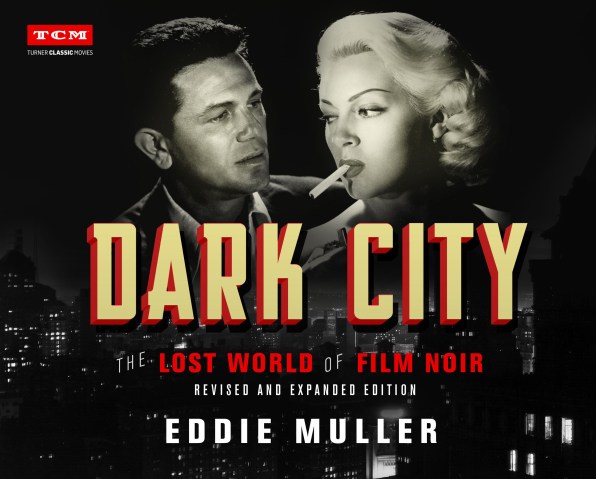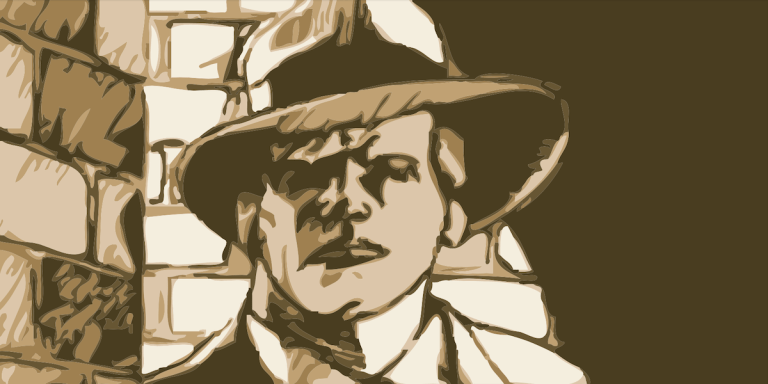The Lost World of Film Noir: Hate Street

Hot wind shakes the sycamores. Leaves dance on the dry lawn. Dad sits at the wheel of the Hudson, staring at their dream house. Room 619 of the Embassy, that’s his dream house now. He can feel her heat on his fingertips. His lips still ache. How can he go back? Mortgage, insurance, scrimping for some new thing, always more things. The ball ’n’ chain is waiting inside with her list. He checks his eyes in the rearview: She’ll never know. Mom sees him through the kitchen curtains, coming up the walk. She thumbs the edge of the kitchen knife: It’s good and sharp.
In Dark City, crime isn’t solely the province of professionals. Between the picket fences and the manicured hedges of the city’s residential enclaves, death is sown daily. Little white lies sprout into deceit, grow into dreadful secrets, and bloom into fateful gunblasts and knife slashes. In this part of town, it’s passion, not profit, that’s at stake.
When dark deeds were done by amateurs, usually the case on Hate Street, the tales were known in the trade as “murder dramas,” distinct from the “crime thrillers” that were the province of crooks and cops. Murder dramas weren’t as male-dominated. In fact, many were what exhibitors called “women’s pictures.” But the distinction was as much one of geography as gender. Crime thrillers took place in the streets and offices where men fought to conquer the city. Murder dramas unfolded in bedrooms and gardens and kitchens, and women wielded their own weapons.
During the hardscrabble 1930s (post–Production Code), Hollywood sold American women an ideal of domestic complacency and economic security. Hang tough, girls—the perfect man, the right neighborhood, and two darling kids were the answers to any soul-searching that tossed you in your sleep. Men had cops and crooks and cowboys to distract and inspire them. For women, films of the 1930s were Sears catalogs of middle-class gratification.
Noir tore the catalog apart. It suggested that domesticity was a suffocating trap. Somewhere amid the laundry and shopping and bill paying, life’s passion had been snuffed out. Noir is about what happens when the fuse is reignited: when a devoted husband takes a new woman in his arms, or a bored wife admits that the life she’s cherished will never satisfy her.
If you can blame one man for screwing up Hollywood’s master plan for matrimonial harmony, it’s James M. Cain. In his tales, the sacred conjugal bed is soaked with the sweat of illicit sex. Before long, the gleaming kitchen tiles are spattered with blood. In Cain’s stories, death and sex are inseparable.
The foundation for Dark City was laid in 1934, when Alfred Knopf published Cain’s first novel, The Postman Always Rings Twice. A fierce tale of adultery and murder, it scored a critical and popular success. Its bluntness and desperation tapped into Depression-era consciousness with prose so spare and vivid it demanded critical appraisal. Its popularity was based on two things: sex rawer than was typical in mainstream novels, and a style so terse it compressed a complex plot into a very slim volume. Mom and Dad could read it fast and hide it easily in a purse or a bureau drawer.
RKO and Columbia saw sparks jump from the manuscript when it was still in galley form. But the newly rejuvenated Production Code Administration—Hollywood’s censorship entity—provided a cold shower. Boss censor Joseph Breen vowed that Postman would never reach the screen. Undaunted, MGM bought the rights. Nothing came of it. No screenwriter could tame Cain, so tightly was the depravity woven into his plots.
Cain followed with a story in Liberty magazine called Double Indemnity. Five studios panted after it, driving up the price to $25,000—even though the PCA declared such amorality off-limits. Meanwhile, Cain kept hammering away. In ’37 he published Serenade, an even more unfilmable concoction of rough sex, homosexuality, murder, and opera.

It wasn’t until 1943 that Billy Wilder, working at Paramount, was able to raise Cain on to American movie screens. (Two versions had already been made in Europe: Le Dernier Tournant [France, 1939] and Ossessione [Italy, 1942], directed by Pierre Chenal and Luchino Visconti, respectively). After Wilder’s writing partner, Charles Brackett, begged off touching such tawdry material, Wilder adapted Double Indemnity with popular detective-story novelist Raymond Chandler. They dealt the censors a miraculous hand of three-card monte, earning approval for the script by cutting Cain’s more debased notions, substituting wicked innuendo for smash-mouth sex, and stressing the moral that even the “perfect crime” would not go unpunished.
Double Indemnity marked the first time a Hollywood film explicitly explored the means, motives, and opportunity of committing murder. Like every story from Hate Street, it’s about people risking their lives on one big chance, in hopes of transcending their mundane existence.
Insurance salesman Walter Neff (Fred MacMurray) takes his risk with Phyllis Dietrichson (Barbara Stanwyck), a client’s dangerously sexy wife. They plot to murder her husband and trick the insurance company into paying double on the “accidental death” clause in his policy. Neff dives into Phyllis’s black pool, intoxicated by her glossy lips, tight sweaters, and flesh-pinching anklet.
But Neff isn’t merely being led around by his libido. Beneath the cavalier manner and playboy patter lurks a terrorist, eager to blow up society’s rigid structures. He longs to refute the constipated worldview of his mentor, claims investigator Barton Keyes (Edward G. Robinson), who believes that human behavior is reducible to statistical demographics and empirical probabilities. So Neff commits murder—just to throw a wrench into the gambling wheel over which Keyes proudly stands watch.
The critical and commercial success of Double Indemnity was due to Wilder’s wizardry in coordinating brilliant collaborators. Chandler goosed Cain’s clipped dialogue into whipcrack sass traded by the stars: There’s a speed limit in this state, Mr. Neff—forty-five miles an hour / How fast was I going, officer? / I’d say around ninety / Suppose you get down off your motorcycle and give me a ticket? / Suppose I let you off with a warning this time / Suppose it doesn’t take / Suppose I have to whack you over the knuckles / Suppose I bust out crying and put my head on your shoulder / Suppose you try putting it on my husband’s shoulder / That tears it.
MacMurray and Stanwyck handled the hard-boiled banter and provocative glances with panache, making murder wickedly entertaining. The PCA may have accepted that Double Indemnity was ultimately about the punishment of immoral people, but Wilder knew its appeal was in the vicarious excitement of participating in a murder, then stepping out of the killers’ shoes and watching the nooses tighten around their necks.
“That gloomy, horrible house the Dietrichsons lived in, the slit of sunlight slicing through those heavy drapes—you could smell that death was in the air, you could understand why she wanted to get out of there, away, no matter how,” Barbara Stanwyck later reflected. “And for an actress, let me tell you—the way those sets were lit, the house, Walter’s apartment, those dark shadows, those slices of harsh light at strange angles—all that helped my performance. The way Billy staged it and John Seitz lit it, it was all one sensational mood.”
Stanwyck, Wilder, and company had turned Cain’s slender novel into the primer for dozens of future noirs, influencing writers and directors for decades to come. Double Indemnity’s success rejuvenated sales of Cain’s earlier books and solidified his (erroneous) reputation as a novelist of the hard-boiled school. His success as an author was a twist worthy of one of his credulity-stretching plots.
James M. Cain was reared in the affluent upper-middle-class environs of Maryland. His parents were Irish Catholics, and, despite his lapsing at age thirteen, vestiges of sin, guilt, and retribution remained. Those formed the backbone of his books. Opera, not literature, was Cain’s love. His mother, a coloratura whom he worshipped, dissuaded him from a singing career. She had, in the tenor of the times, quit her own career to marry a businessman. Cain had little regard for his father, perhaps explaining why he’d write so many stories about ambitious women who murder their way out of unfulfilling marriages.
During the teens and ’20s, Cain struggled at work and marriage. His wife, Mary Clough, was too highbrow for his taste and he cheated on her regularly. He claimed that God’s voice directed him to be a writer, although, by his own admission, he had little aptitude for it. He caught on as a newspaperman, which is how he described himself for the rest of his life. In 1924, his writing career kicked in with acceptance of an article for The American Mercury, H. L. Mencken’s witty journal of American letters.
Cain divorced his wife, moved to New York, and hobnobbed with luminaries like Mencken and Walter Lippmann, kings of elite journalism. He had an affair with Elina Tyszecka, a Finn whom he called “the great love of my life.” Once they married, in 1927, the flame died: “It was gone, that old black magic we had.” Rediscovering passion would be a core motivation for Cain’s characters.
When Cain moved to Hollywood with Elina, he made boatloads of money as a script doctor, without being able to float a salable script of his own. In fact, Cain hated movies. But the discipline of screenwriting, and the sultriness of Southern California, had a profound impact on him.
Bar-B-Q, the manuscript that would become Postman, was lashed out in a blast of May-September desperation before Cain returned East, as if he were spewing out demons in a to-hell-with-it kiss-off of his literary ambitions. Sparking his imagination were impure thoughts about a “bosomy-looking thing” who pumped his gas at the local filling station: “Commonplace, but sexy, the kind you have ideas about.” Cain gave those ideas free rein, shoehorning in details from the case of Ruth Snyder, who had murdered her husband in 1927 and tried to poison her lover/ accomplice.
Almost unwittingly, Cain had become surveyor and architect of Hate Street. The terrain is morally unstable and there is no outlet. When its residents grab their darkest wish, choosing ecstasy over civility, their lives literally climax. Guilt and suspicion slam the lovers head-on into the big black cul-de-sac. You can only hope the sex was worth it.
Cain became so identified with sexually charged murder dramas that he believed Hate Street was his exclusive domain. Monogram’s 1945 release Apology for Murder was such a blatant Cain knockoff industry wags called it Single Indemnity. Despite disdain for any kind of political activism, Cain campaigned within the Screen Writers Guild to create the American Authors Authority, a union that would own its members’ work, negotiate better subsidiary deals, and guard against copyright infringement. It didn’t float, and Cain returned to Maryland, bitterly, continuing to produce novels that tried, with various degrees of success, to replicate the thrill, and popularity, of The Postman Always Rings Twice and Double Indemnity.

While Double Indemnity deserves full credit for jump-starting the noir movement, another tale from Hate Street might have that distinction if not for real-life plot twists. Conflict, directed by German émigré Curtis Bernhardt, from a story by Robert Siodmak, was made at Warners in 1943, but not released until June 1945. Critics called it a knockoff of Double Indemnity when, in fact, it had beaten Billy Wilder to the punch.
The delay was caused by a lawsuit brought against Warners by two writers, claiming the script plagiarized their story. Litigation dragged on for two years before a settlement allowed the film to be released.
Its star, Humphrey Bogart, wished it never had been. Even after he’d captured the public’s imagination as a romantic antihero in hits like High Sierra (1940), The Maltese Falcon (1941), and Casablanca (1942), studio boss Jack Warner couldn’t believe this second banana was now the studio’s top draw. To test the public’s fascination with Bogart, Warners followed Casablanca with Conflict—in which his character is far removed from the savoir faire of Rick Blaine.
Richard Mason (Bogart) is an unhappily married engineer so fixated on his young sister-in-law (Alexis Smith) he arranges an “accident” to kill his wife—after he’s faked an injury that gives him a wheelchair-bound alibi. The accident, on a mountain road, is lifted from The Postman Always Rings Twice, which was yet to be filmed. A load of cut timber tumbles down the mountain and covers the crashed car—so Kathryn Mason (Rose Hobart) is feared dead; the wreck, let alone her corpse, is never found. But Richard is haunted by hints that Kathryn is alive— shades of yet-to-come Diabolique (Filmsonor, 1955)—and he is driven, madly, to confirm his wife’s demise by returning to the scene of crime, which, as we know, is never a good idea.
It was a role Bogart didn’t want to play, as the on-screen marriage was uncomfortably close to his own hellish union with actress Mayo Methot. They were known around town as the “Battling Bogarts,” due to ugly arguments fueled by boatloads of booze. Jack Warner forcing Bogart to play a man who murders his wife seemed like a cruel joke at the actor’s expense.
Robert Siodmak concocted the story with the help of fellow German émigré Alfred Neumann. Siodmak and Curt Bernhardt were friends and colleagues from Berlin, where they’d learned moviemaking in the 1920s before escaping from the Nazis. Bernhardt had a reputation as one of Germany’s finest directors, held in higher regard than Siodmak, who only established himself after several years in Hollywood’s B units. Then the tables turned—Siodmak became an A-list director, rivaling Hitchcock as the “master of suspense,” while Bernhardt never had the cachet, or scripts, that came to his fellow countrymen, like Fritz Lang, Otto Preminger, or Fred Zinnemann. It wasn’t for lack of talent, as Bernhardt showed with his direction of High Wall (MGM, 1947) and Possessed (WB, 1948). If not for a twist of fate, it could have been Curtis Bernhardt, not Billy Wilder, who was the German émigré credited with igniting the film noir movement.
Another 1945 noir, Jealousy (Republic), was one of the odder offerings to emerge from Hate Street. What could have been a dryly cut tale of marital murder is spun every which way by writers Dalton Trumbo and German émigré Arnold Lipp, and Czech director Gustav Machaty. It’s a brooding B about a frisky female cabbie, Janet Urban ( Jane Randolph), mired in a marriage to alcoholic writer Peter Urban (Nils Asther), a cantankerous Czech émigré. Janet drives an affluent doctor ( John Loder) home one day and her knowledge of Brahms wins his heart. A chaste romance ensues, which doesn’t sit well with Peter or the doc’s longtime colleague, Monica (Karen Morley). When Peter is found dead from a point-blank gunshot, Janet is the prime suspect. So far, so noir.
The film’s raison d’être, however, is its depiction of European intellectuals displaced to a strange new land. As Peter, Nils Asther, a gay Swede whose best days were behind him (back when he played the title role in Capra’s The Bitter Tea of General Yen [Columbia, 1932]), curses the plight of European artists adrift in America after fleeing the Nazis, treated like peons by intellectually inferior Americans. His lone friend is another Czech refugee, played by actual Czech refugee Hugo Haas.
Gustav Machaty had soared to notoriety when he directed Ecstasy (Slavia Film, 1933), a provocative film about female sexuality in which future star Hedy Lamarr (yet another Euro-émigré) caused a global sensation by appearing nude. Her exposed derriere was Machaty’s ticket to Hollywood. Once there, he toiled unhappily at MGM, where his experimental approach to cinema was squelched; mostly he directed pickups and retakes, sweeping up after other directors. Jealousy’s most striking moments display Machaty’s distinctively weird style: jagged montages full of Dutch angles and handheld camera moves, abrupt fade-outs, slow-motion close-ups, prowling POV shots, elliptical passages of shadowy dread. The passagework—dialogue-heavy scenes advancing the plot—revealed Machaty’s discomfort with the English language and basic narrative storytelling. He was more poet than storyteller.
If Jealousy was the bottom of the Hollywood barrel circa 1945, Mildred Pierce was the dark crème on top. This Warner Bros. concoction, based on the James M. Cain novel, unveiled one of the legendary dames of Dark City.
People came from miles around to strap on the feedbag at Mildred’s bustling diner, where she served heaping portions of all-American chow. Some guys—if they looked useful—got the special dessert, after hours. Mildred Pierce ( Joan Crawford) was a lower-class woman obsessed with conquering the material world. Like the gangsters of Sinister Heights, she wanted to ensure that her offspring—especially her spoiled daughter Veda—would be welcomed in the swankiest salons.
In her rise from hash slinger to businesswoman, Mildred left a succession of husbands and lovers emasculated. Her true love was Veda, for whom she’d make any sacrifice. In the novel, Veda showed her gratitude by stealing Mildred’s husband, following her bliss to an opera career, and leaving her mother with the solitary crush. On-screen, Veda didn’t run away with lecherous Monte Beregon (Zachary Scott)—she killed him (for spurning her matrimonial desires). Mildred, the matriarchal martyr, took the rap for her precious daughter.
Cain loved Crawford’s version of Mildred, inscribing a leather-bound copy of the book “To Joan Crawford, who brought Mildred to life as I always hoped she would be and who has my lifelong gratitude.” Crawford deserves the credit, and how. But her Oscar-winning portrayal of this woman—mother, moneymaker, homemaker, lover—tapped only a few drops from the dark vein that ran through Crawford herself.
Excerpted from DARK CITY: The Lost World of Film Noir (Revised and Expanded Edition) by Eddie Muller. Copyright © 2021. Available from Running Press, an imprint of Hachette Book Group, Inc.
About the Author
Eddie Muller, aka the “Czar of Noir,” is the host of TCM’s Noir Alley franchise, and the prolific author of novels, biographies, movie histories, plays, and films. He also programs and hosts the “Noir City” film festival series, curates museums, and provides commentary for television, radio, and DVDs. As founder of the Film Noir Foundation, Muller has been instrumental in restoring and preserving more than thirty lost noir classics. He resides in Alameda, CA.
Dark City expands with new chapters and a fresh collection of restored photos that illustrate the mythic landscape of the imagination. It’s a place where the men and women who created film noir often find themselves dangling from the same sinister heights as the silver-screen avatars to whom they gave life. Eddie Muller, host of Turner Classic Movies’ Noir Alley, takes readers on a spellbinding trip through treacherous terrain: Hollywood in the post-World War II years, where art, politics, scandal, style—and brilliant craftsmanship—produced a new approach to moviemaking, and a new type of cultural mythology.
By clicking 'Sign Up,' I acknowledge that I have read and agree to Hachette Book Group’s Privacy Policy and Terms of Use





